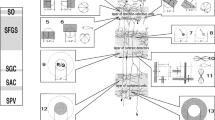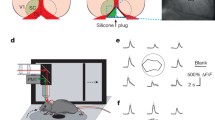Summary
1.600 neurons of the cat's superior colliculus and pretectum were recorded and marked with stainless-steel microelectrodes. The position and structure of receptive fields were tested with stationary flickering and moving stimuli. The position of the stimuli in the visual field was determined by the direction of the lamp projecting the light-points because animal and lamp were arranged in a fixed relationship to the screen. The positions of the stimuli were described in a coordinate system based on the horizontal-and vertical zeromeridean of the retina.
2.About 55% of tectal neurons are directionally selective and signal mainly movements directed to the periphery of the visual field. Neurons of the pretectum have the same response characteristics as neurons of the superior colliculus but in addition some are selectively responsive to movements towards the animal or away from it (S-neurons).
3.Neurons in one functional column (diameter 0.5 mm, length 3.6 mm) perpendicular to the surface of the superior colliculus react to the same position and preferred direction of a moving stimulus. The size, complexity and directional selectivity of the receptive fields increase with the depth of the recorded neurons. The projection of the vertical zero-meridean passes across the rostral part of the colliculus but does not form the rostral border of the superior colliculus. The nasal part of the ipsilateral visual field projects to the most rostral part of the superior colliculus. The projection of the horizontal zeromeridean passes rostro-caudally in a nearly sagittal plane down the middle of the colliculus. Along this projection-line the resolving power is 13°/column in the caudal part and 6°/column in the rostral part of the superior colliculus. The size of the receptive fields increase with their excentricity in the visual field. (Average of field diameters: 26±13°).
4.The diameter of receptive fields in the pretectum was 21±11°, except for a few very large fields (70° and larger). Along the medio-lateral axis of the pretectum there was a retinotopic organization identical to that in the colliculus. Along the caudo-rostral axis, the retinotopic organization was the mirror image of that in the colliculus. No retinotopic organization was observed in the so-called “deep pretectal nucleus” or in the nucleus of the posterior commissure. Neurons of these nuclei may represent more complex levels in the visual pathway.
5.The more superficial neurons of the colliculus (0.1–1.8 mm deep) react mainly with uniform on-, off- or on-off responses to stationary flickered stimuli, i.e. their receptive fields (7–20° in diameter) are uniformly on-, off- or on-off. The deeper neurons (2 mm and deeper) have receptive fields (20–40° in diameter) with compound but not antagonistic structure. No receptive fields showed on- or off-inhibition. Binocularly driven neurons have the same position and structure of their receptive fields for both eyes.
6.A survey of the literature reveals that all vertebrates so far investigated show small differences in the destination and retinotopic organization of their retinofugal fibre projections and in the types of tectal receptive fields. These differences seem to indicate an adaption to the development of binocular representation of the center of the visual field, of a specialized area of the retina and of a retino-cortical system.
Zusammenfassung
1.Von 600 Neuronen des Colliculus superior und Praetectums der Katze wurde mit Stahlmikroelektroden abgeleitet und der Ableitort markiert. Die Lage der rezeptiven Felder wurde mit bewegten und stationären Lichtreizen bestimmt und dem Ableitort zugeordnet.
2.Im Colliculus superior und Praetectum fanden sich richtungsspezifische und richtungsunspezifische Bewegungsneurone. Ein Teil der praetectalen Neurone reagierte richtungsspezifisch auf Bewegungen vom Tier weg und auf das Tier zu (S-Neurone).
3.Innerhalb einer senkrecht zur Oberfläche des Colliculus verlaufenden Penetrationssäule nahm die Feldgröße bei gleichbleibender Feldposition mit zunehmender Tiefe zu. Zwischen Ableitort und Feldposition bestand eine systematische retinotopische Beziehung. Die Projektion des vertikalen O-Meridians des Gesichtsfeldes verlief im rostralen Drittel des Colliculus von medial nach lateral, die des horizontalen O-Meridians in der Mitte des Colliculus von rostral nach caudal. Das Projektionsschema eines Colliculus enthält einen nasalen Teil der ipsilateralen Gesichtsfeldhälfte.
4.Im Praetectum verlief die Projektion vertikaler Meridiane am caudalen Ende von medial nach lateral und überlappte sich teilweise mit dem Projektionsgebiet des vertikalen O-Meridians im Colliculus. Die horizontalen Meridiane verliefen so von caudal nach rostral, daß das Projektionsschema des Praetectums spiegelbildlich zu dem des Colliculus superior angeordnet war. Dieses Projektionsschema galt nur für den Nucleus tractus optici und die Area praetectalis. Die übrigen praetectalen Kerne mit zum Teil sehr großen rezeptiven Feldern und spezifischen Reaktionsweisen erhielten keine retinotopische Projektion.
5.Rezeptive Felder der oberflächennahen Schichten waren uniform on-, off-oder on-off strukturiert, Felder tiefergelegener Einheiten waren ungeordnet aus on-, off- und on-off Bezirken zusammengesetzt. Binocular erregbare Neurone zeigten für beide Augen gleiche Position und Struktur der rezeptiven Felder.
6.Die Ergebnisse wurden mit den an anderen Tierarten erhobenen Befunden verglichen. Ihre mögliche funktionelle Bedeutung wurde diskutiert.
Similar content being viewed by others
Literatur
Apter, J. T.: Projection of the retina on superior colliculus in cats. J. Neurophysiol. 8, 123–134 (1945).
Ariëns Kappers, C. U., Huber, G. C., Crosby, E. C.: The comparative anatomy of the nervous system of vertebrates, including man, vol. II, p. 868. New York: Hafner Publishing Company 1960.
Barlow, H. B., Hill, R. M.: Selective sensitivity to direction of movement in ganglion cells of the rabbit retina. Science 139, 412–414 (1963).
—, Levick, W. R.: The mechanism of directionally selective units in rabbit's retina. J. Physiol. (Lond.), 178, 477–504 (1965).
Barris, R. W., Ingram, W. R., Ranson, S. W.: Optic connections of the diencephalon and midbrain of the cat. J. comp. Neurol. 62, 117–155 (1935).
Bishop, P. O., Kozak, W., Levick, W. R., Vakkur, G. J.: The determination of the projection of the visual field onto the lateral geniculate nucleus in the cat. J. Physiol. (Lond.) 163, 503–539 (1962).
Bucher, V. M., Bürgi, S. M.: Some observations on the fiber connections of the diand mesencephalon in the cat. II. Fiber connections of the pretectal region and the posterior commissure. J. comp. Neurol. 96, 139–178 (1952)
Bürgi, S.: Das Tectum opticum. Seine Verbindungen bei der Katze und seine Bedeutung beim Menschen. Dtsch. Z. Nervenheilk. 176, 1–16 (1957).
Cavaggioni, A., Madaràśz, I., Zampollo, A.: Photic reflexes and Pretectal region. Arch. ital. Biol. 106, 227–242 (1968).
Creutzfeldt, O., Ito, M.: Functional synaptic organization of primary visual cortex neurones in the cat. Exp. Brain Res. 6, 324–352 (1968).
Cronly-Dillon, J. R.: Units sensitive to direction of movement in goldfish. Nature (Lond.) 203, 214–215 (1964).
Dixon, W. J., Massey, F. J., Jr.: Introduction to statistical analysis. New York-Toronto-London: McGraw-Hill Book Co. 1957
Ewert, J.-P.: Der Einfluß von Zwischenhirndefekten auf die Visomotorik im Beuteund Fluchtverhalten der Erdkröte. Z. vergl. Physiol. 61, 41–70 (1968).
Garey, L. J., Powell, T. P. S.: The projection of the retina in the cat. J. Anat. (Lond.) 102, 189–222 (1968).
Hamdi, F. A., Whitteridge, D.: The representation of the retina on the optic tectum of the pigeon. Quart. J. exp. Physiol. 39, 111 (1954).
Heric, T. H., Kruger, L.: Organisation of the visual projection upon the optic tectum of a reptile (Aligator mississipp.) J. comp. Neurol. 124, 101–112 (1965).
Hess, W. R., Bürgi, S., Bucher, V.: Motorische Punktionen des Zektal- und Tegmentalgebietes. Mschr. Psychat. Neurol. 112, 1–52 (1946).
Horn, G., Hill, R. M.: Responsiveness to sensory stimulation of units in the superior colliculus of the rabbit. Exp. Neurol. 14, 199–223 (1966).
Hubel, D. H., Wiesel, T. N.: Receptive fields, binocular interaction and functional architecture in the cat's visual cortex. J. Physiol. (Lond.) 160, 106–154 (1962).
—: Receptive fields and functional architecture in two non-striate visual areas (18 and 19) of the cat. J. Neurophysiol. 28, 229–289 (1965).
Humphrey, N. K.: Responses to visual stimuli of units in the superior colliculus of rats and monkeys. Exp. Neurol. 20, 312–340 (1968).
Jacobson, M.: The representation of the retina on the optic tectum of the frog. Correlation between retinotectal magnification factor and retinal ganglion cell count. Quart. J. exp. Physiol. 49, 170–178 (1962).
Laties, A. M., Sprague, J. M.: The projection of optic fibers to the visual centers in the cat J. comp. Neurol. 127, 35–70 (1966).
Lettvin, J. Y., Maturana, H. R., Pitts, W. H., McCulloch, W. S.: Two remarks on the visual system of the frog. In: Sensory communication, ed. W. A. Rosenblith, p. 757–776. M. I. T.-Press, Mass. 1961.
Maturana, H. R., Frenk, S.: Directional movement and horizontal edge detectors in the pigeon. Science 142, 977–979 (1963).
McIlwain, J. T., Buser, P.: Receptive fields of single cells in the cat's superior colliculus Exp. Brain Res. 5, 314–325 (1968).
Michael, C. R.: Integration of visual information in the superior colliculus. J. gen. Physiol. 50, 2485–2486 (1967).
Schaefer, K. P.: Mikroableitungen im Tectum opticum des frei beweglichen Kaninchens Arch. Psychiat. Nervenkr. 208, 120–146 (1966).
Schwassmann, H. O.: Visual projection upon the optic tectum in a foveate marine teleost. Vision Res. 8, 1337 (1968).
—, Kruger, L.: Organisation of the visual projection upon the optic tectum of fish. J. comp. Neurol. 124, 113–126 (1965).
Siminoff, R., Schwassmann, H. O., Kruger, L.: An electrophysiological study of the visual projection to the superior colliculus of rat. J. comp. Neurol. 127, 435–444 (1966).
—: Unit analysis of the pretectal nuclear group in the rat. J. comp. Neurol. 130, 329–342 (1967).
Snider, R. S., Niener, W. T.: A stereotaxic atlas of the cat brain, Chicago: Chicago of University Press 1961.
Sprague, J. M., Meikle, T. H.: The role of the superior colliculus in visually guided behavior Exp. Neurol. 11, 115–146 (1965).
—, Marchiafava, P. L., Rizzolatti, G.: Unit responses to visual stimuli in the superior colliculus of the unanesthesized, mid-pontine cat. Arch. ital. Biol. 106, 169 (1968).
Sterling, P., Wickelgren, B. G.: Visual receptive fields in the superior colliculus of the cat. J. Neurophysiol. 32, 1–16 (1969).
Stone, J.: The naso-temporal division in the cat's retina. J. comp. Neurol. 126, 585–599 (1966).
Straschill, M., Hoffmann, K. P.: Functional aspects of localisation in the cat's tectum opticum. Brain Res. 13, 274–283 (1969).
—: Effect of D-Amphetamine on the activity of single neurones of the cat's tectum opticum. Experientia (Basel) 25, 373 (1969).
—, Taghavy, A.: Neuronale Reaktionen im Tectum opticum der Katze auf bewegte und stationäre Lichtreize. Exp. Brain Res. 3, 353–367 (1967).
Vakkur, G. J., Bishop, P. O., Kozak, W.: Visual optics in the cat, including posterior nodal distance and retinal landmarks. Vision Res. 3, 289–314 (1963).
Viktorow, I. V.: Neuronal structures of the superior colliculus in the cat. [In Russisch, engl. Zus. fass.) Arch. anat. histol. Embryol. 2, 45–55 (1968).
Wickelgren, B. G., Sterling, P.: Influence of visual cortex on receptive fields in the superior colliculus of the cat. J. Neurophysiol. 32, 16–24 (1969).
Author information
Authors and Affiliations
Rights and permissions
About this article
Cite this article
Hoffmann, KP. Retinotopische Beziehungen und Struktur rezeptiver Felder im Tectum opticum und Praetectum der Katze. Z. Vergl. Physiol. 67, 26–57 (1970). https://doi.org/10.1007/BF00298118
Received:
Issue Date:
DOI: https://doi.org/10.1007/BF00298118




